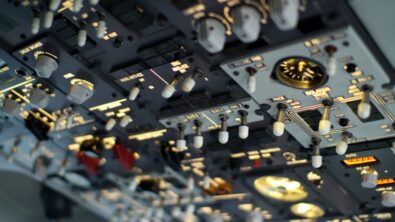Talking Aerospace Today – Generative Design for Electrical Systems Part One – Summary

The Talking Aerospace Today podcast has come a long way in its examination of digital transformation maturity, having finished its segments on the automation stage and the role of artificial intelligence (AI). Now the podcast is ready to delve into the fourth stage of digital transformation maturity: generative design.
Generative design looks different across engineering domains, so in this episode, Todd Tuthill, Vice President of Aerospace and Defense (A&D) for Siemens Digital Industries Software, is joined by Anthony “Tony” Nicoli, Senior Director for Aerospace at Siemens, discuss it in terms of electrical systems. The two of them introduce the concept of generative design in the context of digital transformation maturity, as well as discuss what generative technology is available for today’s electrical systems and how the A&D industry can benefit from such technology.
The dream of generative design
In the context of digital transformation maturity, generative design is the idea of automatically generating design artifacts, such as a wing for an aircraft design, based on a set of defined parameters. Engineers will not be generating entire aircraft or spacecraft with the click of a button any time soon, but the goal is to gradually generate larger components and systems as the technology and generative algorithms develop.
Indeed, generative design has long been a goal for engineers working in the electrical domain. Todd mentions a time when he worked at a previous company and his team tried to create an “easy button” that could generate electrical schematics for them. They did not succeed back then, but Todd believes with all the recent advancements in AI and machine learning, the potential for full generative design to be realized has never been greater.
The foundation is laid
In fact, Tony mentions some instances where generative efforts—perhaps not on the full scale of generative design Todd talks about—have made a big impact for aerospace engineers by generating assets to improve workflow. The people working on the James Webb Space Telescope, for example, used generative algorithms in their electrical and electronics software to increase their overall workload by 30 percent without increasing the size of their teams. They also managed to increase their overall program efficiency by 50 percent. In another example, a Siemens customer eliminated 94 percent of the time it usually took them to create technical manuals with the use of generative algorithms.
While these examples are not directly generative design, they are helping connect information along the product lifecycle and automate mundane tasks, thereby augmenting the productivity and creativity of the engineers. These instances are the foundation that will lead to the full realization of the technology.
The future is in reach
The returns on investment from the examples above demonstrate just how vital generative technology will be for not just future aerospace design. The same technology can be used in the development process, manufacturing, product support and beyond, saving time and money across the entire product lifecycle.
Additionally, nobody ever designs products once in the A&D industry, and that fact will only become more prevalent as future products increase in complexity. Generative design can speed up design creation to keep up with reiterated designs and new variants, as well as learn to create new designs increasingly accurate to desired specifications.
Generative design is still quite a distance away from realization, but the technology to attain it is already here. Generative algorithms are already used across the A&D industry to help develop electrical systems and improve workflows, and with additional investment, they can one day be advanced enough to take on the more complex tasks and designs Todd describes. The A&D industry may still not have its easy button, but it is certainly on the path toward building it.
Stay tuned for the second part of this conversation on the next episode of Talking Aerospace Today.
Siemens Digital Industries Software helps organizations of all sizes digitally transform using software, hardware and services from the Siemens Xcelerator business platform. Siemens’ software and the comprehensive digital twin enable companies to optimize their design, engineering and manufacturing processes to turn today’s ideas into the sustainable products of the future. From chips to entire systems, from product to process, across all industries. Siemens Digital Industries Software – Accelerating transformation.


